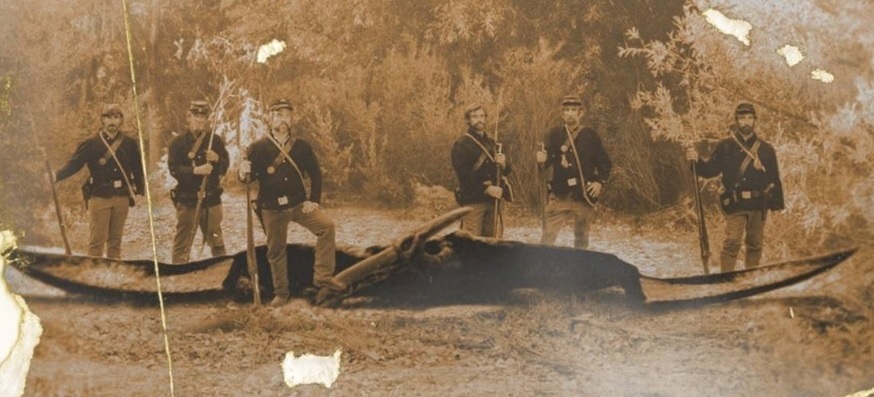By Jonathan Whitcomb
Featherless flying reptiles appear to live across the globe, shocking and sometimes frightening eyewitnesses of these apparent modern pterosaurs. The animals are also called “pterodactyls” or even “flying dinosaurs” or “dinosaur birds”.
If it has a long tail, it is called “ropen”, but in some areas of Africa this reptile-creature is known as “kongamato”. In old times, even centuries ago, it was called “dragon”, and in fact some eyewitnesses still use that word, even in the United States.
.
Photograph of an apparent modern pterosaur in the 19th century
The “Civil War” pterodactyl photo “Ptp” now appears significant
Recent eyewitness reports of apparent non-extinct “pterodactyls” may now be taken into context with a new assessment of an old photo called “Ptp”. The above image is the main portion of that photo, showing six apparent Union Civil War soldiers and what looks like some kind of gigantic Pteranodon.
The following are some of the main points recently discovered on these men, and other aspects of the image support the conclusions. By the way, the uniforms and equipment were not from the Civil War but later in the 19th century, probably between about 1866 and 1880:
1) Each of the six men seems to be a common soldier (not officer)
2) The belt buckles are not oval but rectangular
3) Each of the six men has a pistol holster
4) One of the men is left handed, shown by the left-handed holster
5) Unlike with a typical group of Civil War reenactors, not one of the men in Ptp is clean-shaven, although they generally have some variety in their beards and mustaches
6) Each man holds a rifle but not one is in anything like a firing position
7) The general body build is neither thin nor heavyset
8) The lighting of the clothing is reasonable and consistent
9) Their stances together are neither regimented nor very informal
10) The man in front of the creature was very likely photographed in that position: closer to the camera when compared with the other men
What is the conclusion? Those six men were very likely to have been photographed as they appear and WITH the apparent pterosaur. Was it a biological creature or just a model of one? That is another question, but it was very likely to have been a physical object, NOT a drawing or painting or digital model.
By the way, that one left-handed pistol holster, along with other factors, practically proves that those men were not actors pretending to be soldiers living in the 19th century. They were surely what they appear to be: men who had lived together at some time between about 1866 and 1880.

.
The 19th century photo in context with recent sightings
One of the objections made by some critics is in a question like this: “Why is there no clear photograph of a modern pterodactyl?” The Ptp photo answers that question: This image was, in its original form, more likely than not, obtained through photographing six men standing next to an actual modern pterosaur.
Some of the sightings of these flying creatures in the 20th and 21st centuries are consistent, at least in some aspects, with the flying creature seen in Ptp. In fact, some of the reports suggest a size even greater than the “monster” in that 19th century photo.
.
###
.
Reports of Pterodactyl Sightings in the United States
I realized this was no ordinary bird but appeared more like a featherless reptile. I watched as it flew above the water and into the other leg of the pond and out of sight.
.
Press releases on living pterosaurs
As of mid-2022, at least 21 press releases are available online regarding eyewitness sightings of apparent living pterosaurs.
.
First, look at the general appearance of those six men. Of course they have individual differences, but look at the similarities. . . .
Those are NOT images of soldiers cut from various photos and then pasted together. Those men appear to have lived together, eaten together, and spent time together. In other words, they were also photographed together.
.
Pterodactyl sighting – report it here
Contact form for starting email communication – you can be anonymous
.
Pterosaurs or pterodactyl around the world
At least three scientific papers have been published on the subject of modern pterosaurs. In addition, many nonfiction books have been written on these flying creatures, as well as over a thousand web pages and blog posts . . .
.
Rhamphorhynchoid pterosaurs are well known from fossils: long-tailed, with a particular head-neck-spine conformity unlike the average Pterodactyloid. . . . modern versions of those long-tailed pterosaurs can be almost any size, and that means a few are huge: bigger than fossils yet discovered.
.
Pterodactyl or “flying dinosaurs”
Questions and answers on these living pterosaurs
.
The following image (Ptp) may have originated from a genuine photograph in the 19th century, although it was very unlikely to have been during the American Civil War, which ended in 1865.
.
Objections that critics have made on this apparent pterodactyl and some insightful answers and refutations to those skeptical remarks.
.
A newspaper article was published in Salt Lake City, about a century ago, reporting a huge flying creature described as half-bird and half-reptile. How big was it? The image coming with that article showed a dragon flying off with a horse in its mouth.
.



